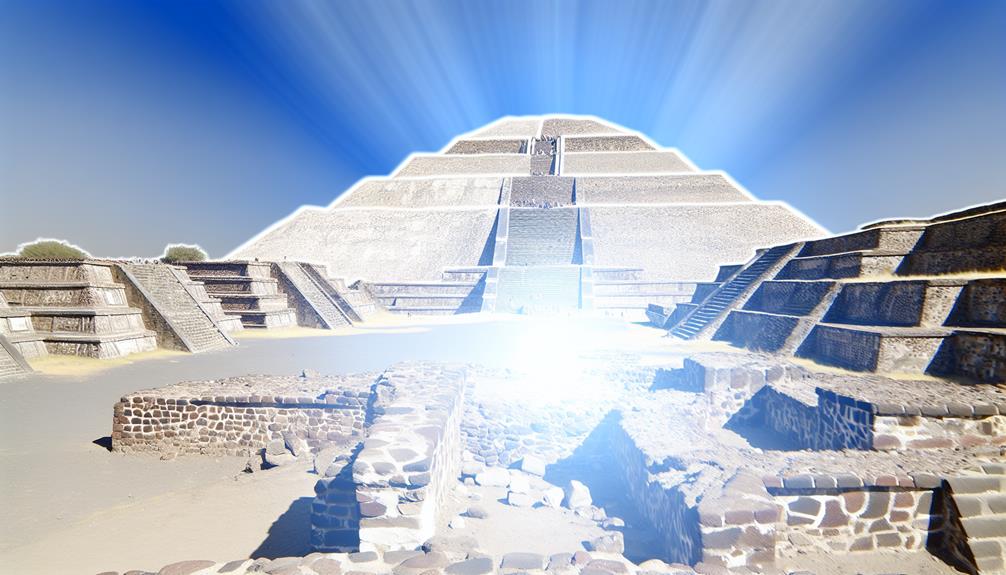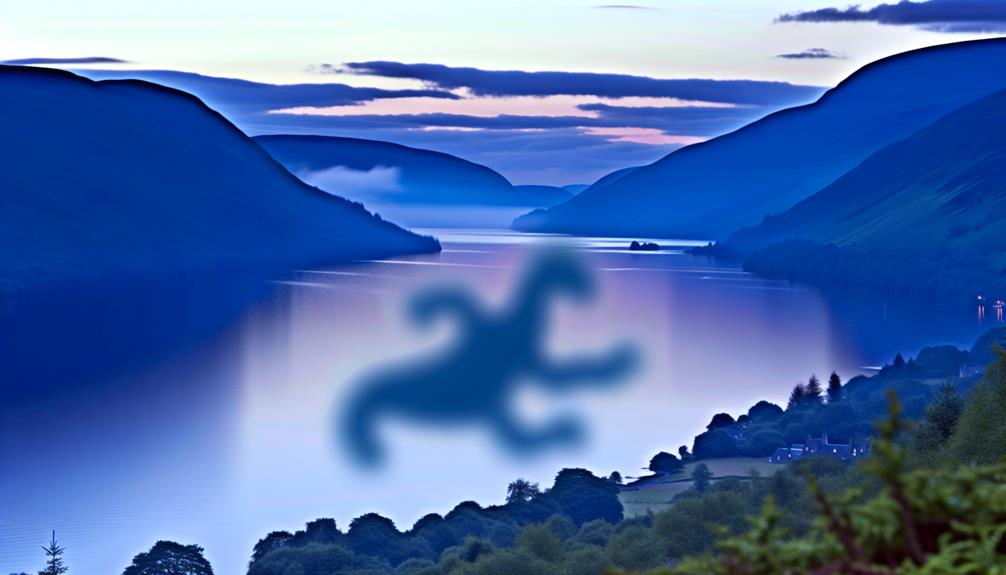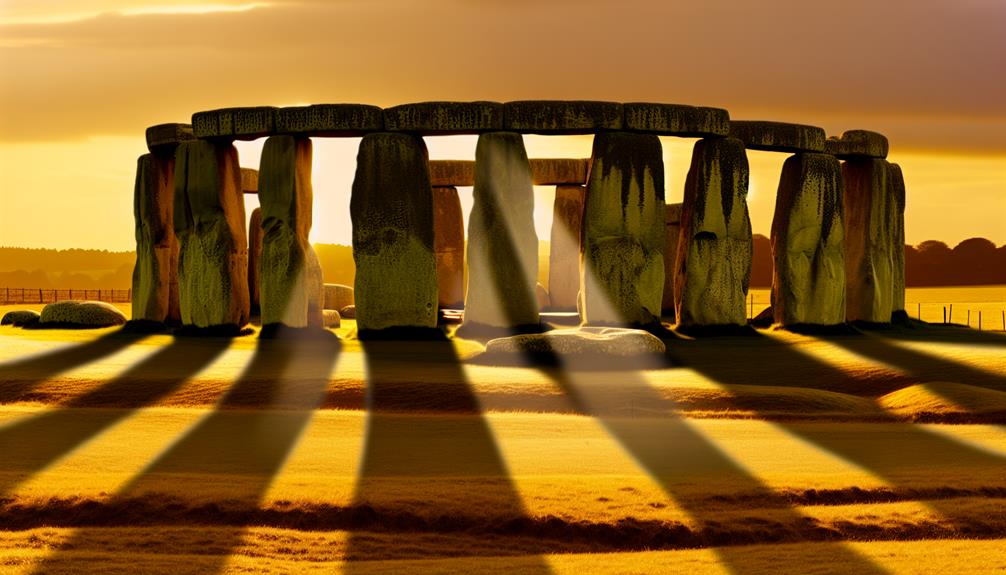Nestled in the heart of Mexico lies the enigmatic ancient city of Teotihuacan, a UNESCO World Heritage site that intrigues historians and archaeologists alike. From its grand pyramids to the intricate murals adorning its walls, Teotihuacan whispers tales of a civilization long gone yet deeply influential. The mysteries surrounding its origins and sudden decline continue to puzzle scholars, inviting them to unravel the enigmas that shroud this once-thriving metropolis.
Key Takeaways
- Ancient Mesoamerican city with a history dating back to 100 BCE.
- Impressive architecture including pyramids with celestial alignments.
- Rich religious significance reflected in pyramids and murals.
- Complex social structure with distinct roles and advanced agriculture.
- Decline possibly due to droughts, social unrest, and external factors.
The History of Teotihuacan
Teotihuacan, an ancient Mesoamerican city located in present-day Mexico, boasts a rich and complex history that dates back to around 100 BCE. The history of Teotihuacan is elucidated through archaeological discoveries that provide insights into the cultural influences that shaped this magnificent city.
Archaeological excavations at Teotihuacan have unearthed a plethora of artifacts, murals, and structures that offer a glimpse into the city's past. One of the most significant archaeological discoveries at Teotihuacan is the Pyramid of the Sun, a colossal structure that stands as a reflection of the advanced architectural and engineering skills of its builders. The intricate carvings and paintings found within the city depict scenes of everyday life, religious rituals, and the deities worshipped by its inhabitants, shedding light on the cultural practices and beliefs of the Teotihuacan people.
The cultural influences that permeated Teotihuacan are evident in its art, architecture, and religious practices. The city's layout, with its grand avenues, temples, and residential compounds, reflects a sophisticated urban planning system that was likely influenced by earlier Mesoamerican civilizations. The presence of distinct architectural styles and artistic motifs further attests to the multicultural nature of Teotihuacan, where diverse groups coexisted and contributed to the city's vibrant cultural tapestry.
Architecture and Urban Layout
The architectural design and urban layout of Teotihuacan provide profound insights into the sophisticated planning and construction techniques employed by its ancient inhabitants, reflecting a harmonious blend of functionality and symbolic significance. The city's urban planning is characterized by its grid-like layout, with streets aligned in a precise north-south orientation. This meticulous planning suggests a high level of centralized authority and advanced engineering skills among the Teotihuacanos. The main thoroughfare, known as the Street of the Dead, served as the city's central axis, connecting various important structures such as the Pyramid of the Sun and the Pyramid of the Moon.
Architecturally, the pyramids of Teotihuacan showcase the engineering prowess of its builders. The Pyramid of the Sun, the largest structure in the city, stands as a demonstration of the precision and mathematical knowledge of the Teotihuacanos. Its symmetrical design and alignment with celestial bodies indicate a deep understanding of astronomy and a reverence for the natural world. The use of talud-tablero architectural style, characterized by sloping walls and rectangular panels, further highlights the artistic and technical achievements of the civilization.
Religious Significance of Pyramids
Exemplifying a profound spiritual connection, the pyramids of Teotihuacan in Mexico stand as monumental expressions of the religious significance embedded within their architectural grandeur. These ancient structures played a central role in the religious practices of the Teotihuacan civilization, reflecting their complex spiritual beliefs and ritual practices.
The layout and design of the pyramids were not merely architectural feats but were intricately linked to the religious worldview of the Teotihuacanos. The Pyramid of the Sun, the largest structure in Teotihuacan, is believed to have held significant religious importance, possibly dedicated to the worship of deities associated with the sun. Its orientation towards celestial events such as the sunrise during specific times of the year underscores the spiritual significance attributed to it.
Moreover, the Pyramid of the Moon, positioned at the northern end of the Avenue of the Dead, likely had its own ritualistic purposes tied to the cycles of the moon and fertility beliefs. The intricate carvings and murals found within the pyramids further depict scenes that are thought to be related to religious ceremonies, mythological narratives, and cosmological beliefs held by the Teotihuacan people.
Art and Murals in Teotihuacan
Within the elaborate architectural landscape of Teotihuacan, the art and murals intricately woven into the structures provide profound insights into the cultural and artistic expressions of the ancient civilization. The art in Teotihuacan reflects a sophisticated understanding of symbolism and artistic techniques, showcasing the advanced level of creativity and skill possessed by its inhabitants.
- Symbolism: The murals in Teotihuacan are rich in symbolic representations, often depicting deities, mythological creatures, and celestial objects. These symbols were believed to hold significant religious and cosmological meanings for the ancient Teotihuacanos, offering a window into their belief systems and worldview.
- Techniques: The artists in Teotihuacan employed various techniques to create their masterpieces, including the use of natural pigments, stucco relief, and fresco painting. The vibrant colors and intricate details found in the murals indicate a high level of artistic expertise and a deep understanding of color symbolism and composition.
- Artistic Innovation: The art and murals of Teotihuacan demonstrate a remarkable level of artistic innovation for their time, with unique stylistic elements and creative expressions that set them apart from other Mesoamerican cultures. The artists' ability to blend tradition with innovation resulted in a visual language that is both timeless and enthralling, offering modern viewers a glimpse into the artistic brilliance of the ancient Teotihuacanos.
Daily Life in the Ancient City
Reflecting the essence of ancient civilization, daily life in Teotihuacan reveals a tapestry of societal interactions and cultural practices that shaped the rhythmic heartbeat of the city. The social structure of Teotihuacan was complex, with a hierarchical system that influenced various aspects of daily life. At the top of the social hierarchy were the rulers and nobles, followed by priests, artisans, traders, and farmers. This structure governed interactions, labor division, and access to resources within the city.
Agricultural practices were fundamental to the sustenance of Teotihuacan's population. The city's residents engaged in advanced farming techniques, such as terraced agriculture, irrigation systems, and crop rotation. Maize, beans, squash, and chili peppers were staple crops that formed the basis of their diet. The surplus produced from agriculture supported trade within the city and with neighboring regions, enhancing the economic prosperity of Teotihuacan.
Below is a table highlighting key aspects of daily life in Teotihuacan:
| Aspect | Description | Importance |
|---|---|---|
| Social Structure | Hierarchical system influencing interactions | Organized labor division |
| Agricultural Practices | Advanced techniques such as terraced farming | Sustenance and economic growth |
| Staple Crops | Maize, beans, squash, chili peppers | Dietary foundation |
| Trade | Supported by agricultural surplus | Economic prosperity |
| Labor Division | Varied roles based on social hierarchy | Efficient resource utilization |
Decline and Abandonment
The decline and eventual abandonment of Teotihuacan, Mexico, marked a significant turning point in the city's history, prompting scholars to investigate the factors that led to its downfall. Through archaeological research and historical evidence, several theories have emerged to explain the decline and mysterious abandonment of this once-vibrant city:
- Environmental Factors: Some researchers suggest that environmental factors such as droughts, deforestation, and soil depletion played a significant role in the decline of Teotihuacan. These factors could have led to agricultural difficulties, food scarcity, and ultimately, societal unrest.
- Social Unrest: Another theory proposes that internal social unrest, possibly stemming from political conflicts, class struggles, or religious upheavals, contributed to the downfall of Teotihuacan. Evidence of violent events and upheavals found in archaeological excavations supports this hypothesis.
- External Invasions: There is also speculation about external invasions by neighboring groups as a potential cause for the city's decline. These invasions could have disrupted trade routes, destabilized the region, and led to the abandonment of Teotihuacan by its inhabitants.
The archaeological record continues to provide insights into the enigmatic decline and abandonment of Teotihuacan, leaving this ancient city shrouded in mystery and intrigue for researchers and visitors alike.
Modern Preservation Efforts
In recent years, concerted efforts by archaeological institutions, governmental bodies, and local communities have been directed towards the preservation and conservation of Teotihuacan, Mexico, aimed at safeguarding this ancient site for future generations. Various preservation techniques have been employed to guarantee the longevity of the site and to protect it from environmental and human-induced damage. Additionally, ongoing archaeological discoveries continue to shed light on the mysteries of Teotihuacan, providing valuable insights into its history and significance.
To provide a visual representation of the preservation efforts at Teotihuacan, the following table outlines some key strategies and initiatives:
| Preservation Techniques | Description | Impact |
|---|---|---|
| Structural Stabilization | Reinforcement of buildings and pyramids | Prevents collapse and maintains structural integrity |
| Site Monitoring | Regular inspections and maintenance | Early detection of issues for timely intervention |
| Community Engagement | Involvement of local communities in preservation activities | Fosters a sense of ownership and pride in the site |
These preservation techniques, coupled with the continuous archaeological discoveries, not only protect the physical remains of Teotihuacan but also contribute to a deeper understanding of its cultural significance. By combining modern conservation practices with traditional knowledge, Teotihuacan stands a better chance of being preserved for future generations to appreciate and study.
Visiting Teotihuacan Today
With its rich historical significance and architectural marvels, exploring Teotihuacan today offers visitors a fascinating journey into the ancient civilization of Mexico. The site's grandeur and cultural importance make it a must-visit destination for history enthusiasts and curious travelers alike.
- Tourist Experience:
- Visitors can climb the towering Pyramid of the Sun, marvel at the intricate murals in the Palace of the Jaguars, and walk along the Avenue of the Dead, imagining life in this ancient city.
- Guided tours provide insightful commentary on the history and significance of Teotihuacan, enhancing the overall visitor experience.
- Hot air balloon rides offer a unique perspective of the site from above, allowing tourists to appreciate the vastness and layout of the ancient city.
- Local Cuisine:
- After a day of exploration, visitors can indulge in authentic Mexican cuisine at the local eateries near the archaeological site.
- Traditional dishes such as tacos, tamales, and pozole provide a taste of the region's culinary heritage.
- Sampling street food from vendors selling elotes (corn on the cob) and aguas frescas (fruit drinks) adds a delightful culinary dimension to the Teotihuacan experience.
Frequently Asked Questions
How Did the Residents of Teotihuacan Communicate With Each Other?
Hieroglyphic communication was a key method used by ancient societies to convey messages, symbolize concepts, and record events.
Within social hierarchies, this form of communication played an essential role in maintaining order, transmitting knowledge, and reinforcing power structures.
Through the use of symbols, images, and written language, individuals at different levels of society could exchange information, solidify relationships, and uphold traditions within their community.
What Were the Main Sources of Food for the People of Teotihuacan?
Agricultural practices and hunting techniques were essential for sustaining the populace.
The community primarily relied on farming to cultivate maize, beans, squash, and other crops. They utilized advanced irrigation systems and terraced fields to maximize agricultural output.
In addition to agriculture, hunting played a significant role in providing protein sources. Residents employed various hunting methods, such as traps and spears, to capture wild game like deer and rabbits.
These combined efforts guaranteed a diverse and sustainable food supply.
Were There Any Specific Burial Rituals or Traditions in Teotihuacan?
Burial customs are significant markers of cultural practices and beliefs. They often reflect a society's views on life, death, and the afterlife. Community rituals surrounding death can vary widely, from elaborate ceremonies to simple internments.
These practices provide insights into the values and social structures of a civilization. Understanding the burial customs and traditions of a society like Teotihuacan can offer valuable clues about their religious beliefs and societal organization.
What Types of Tools or Technologies Did the Ancient Teotihuacanos Use?
Ancient tools and technologies utilized by civilizations reflect their ingenuity and resourcefulness. In examining Teotihuacan craftsmanship, we uncover a rich tapestry of techniques and implements that showcase the skills of its inhabitants.
From stone tools for construction to pottery-making implements, the Teotihuacanos employed a variety of tools to shape their world. Understanding these ancient technologies provides a window into the innovative spirit of this ancient civilization.
How Did the Ancient City of Teotihuacan Influence Neighboring Civilizations?
Cultural exchanges between ancient cities often shape neighboring civilizations through the diffusion of ideas, beliefs, and practices. Architectural influences can be particularly impactful, as they showcase a society's advanced techniques and aesthetics, inspiring nearby communities to adopt similar styles.
This exchange can foster a sense of interconnectedness and shared heritage among civilizations, leading to the development of unique cultural identities that reflect a blend of influences from various sources.
Conclusion
In the heart of Teotihuacan, Mexico, lies a tapestry of ancient history woven through intricate murals, towering pyramids, and a complex urban layout.
The legacy of this Mesoamerican civilization is a vivid proof of human ingenuity and spirituality, inviting visitors to climb the pyramids, admire the art, and immerse themselves in the vibrant culture of a bygone era.
Teotihuacan stands as a timeless reminder of the power of human creativity and the enduring heritage of ancient civilizations.


